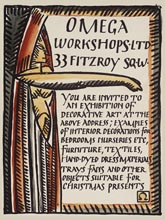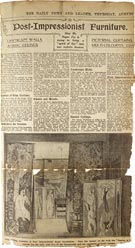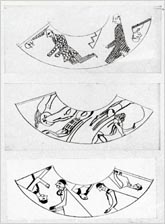|
Background and aims |
Artists and patrons |
Omega work |
Omega's decline
Background and aims

 |
Omega design letterhead
© Annabel Cole |
In July 1913 Omega Workshops Ltd opened to the public at 33 Fitzroy Square in the heart of London's Bloomsbury.
The workshops incorporated public showrooms as well as studios, and were staffed by a business manager, caretaker and a group of artist assistants.
Vanessa Bell, Duncan Grant and Roger Fry were named as Directors.
Roger Fry founded and was the driving force behind the Omega Workshops. Unlike his most obvious predecessors William Morris and the designers of the Arts and
Crafts Movement, Fry was not concerned with social reform or protesting against contemporary machine manufacture, but wanted to remove what he saw as the false
division between the fine and decorative arts.
He was keen to see some of the key ideas of Post-Impressionism, such as bright colours and bold, simplified forms, applied to design, as in these candle shades designed by
Wyndham Lewis (below). |

Invitation to the opening of
the Omega Workshops
© Henrietta Garnett
All rights reserved |

The Daily News and Leader, 'Post Impressionist Furniture'
© Associated Newspapers Ltd. |

Candle shade designs
by Wyndham Lewis, 1913
© Tate Archive, 2003 |
Fry also wanted to help his artist friends by providing them with the chance to make a living designing and decorating furniture, textiles and other household accessories,
alongside their artistic careers.
Fry felt that objects and furniture should be bought for their aesthetic qualities rather than the reputation of the artist, so he insisted that all work was produced anonymously.
Designs were unsigned and marked only with the symbol Ω, the Greek letter 'Omega'.
'Omega' is the last letter of the Greek alphabet, and in the late nineteenth century it was used to mean the 'last word' on a subject. |
|
